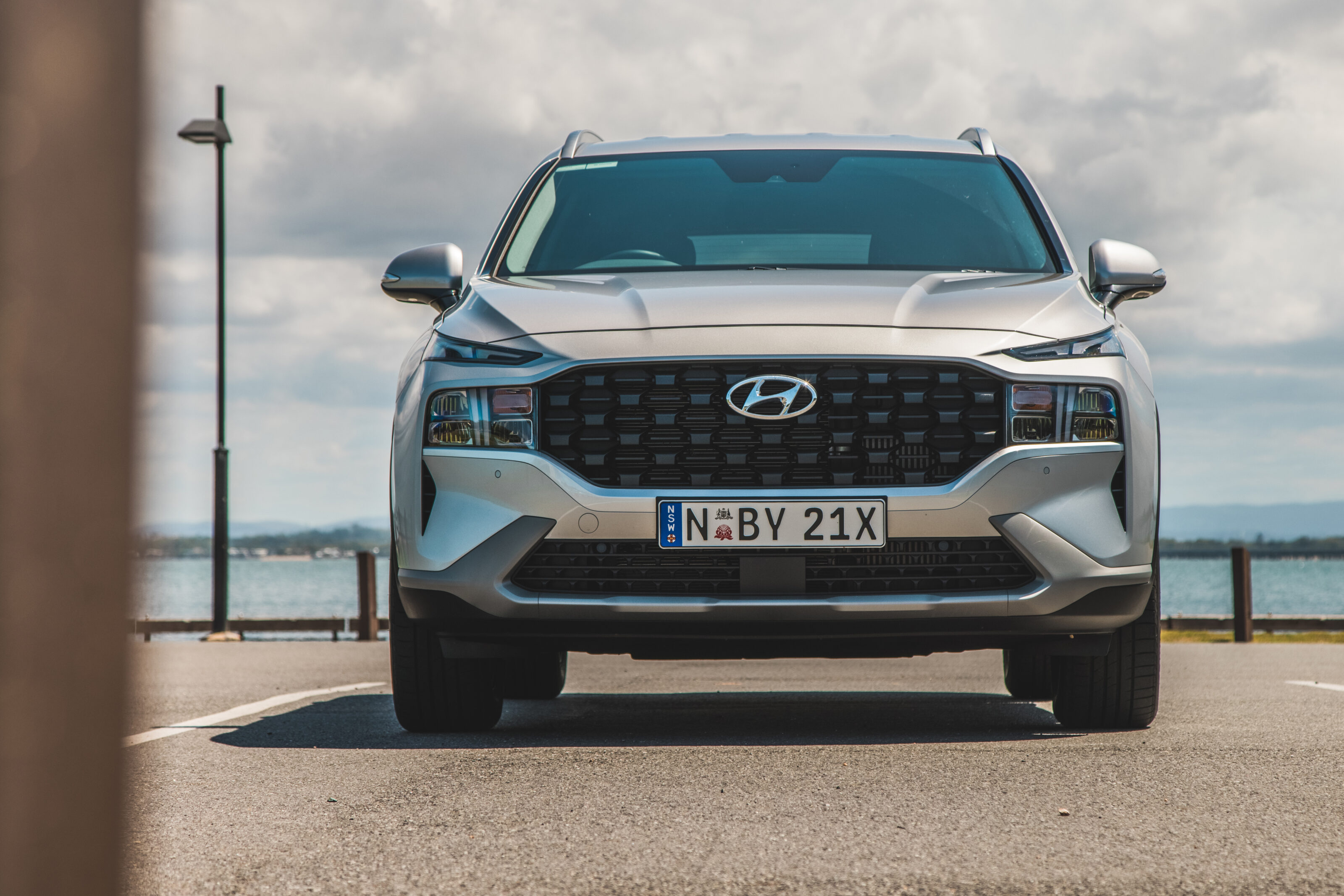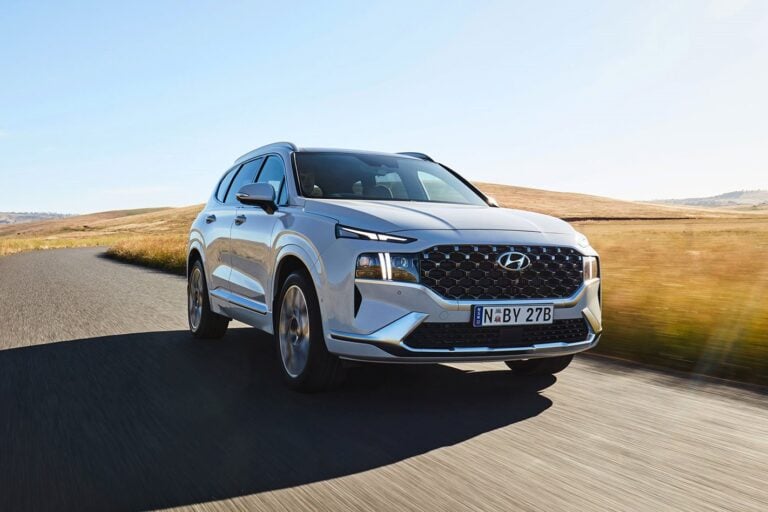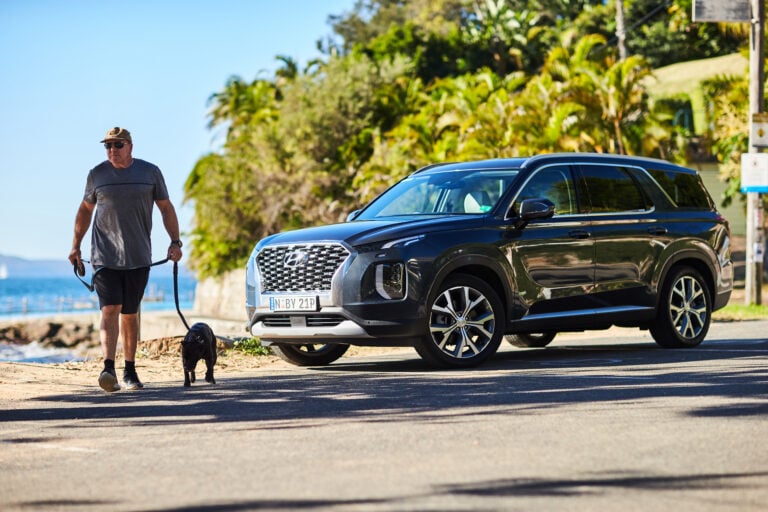Score breakdown
Things we like
- Value for money
- Quality and comfort
- Fuel consumption
Not so much
- Poor third-row access and space
- No third-row airbags
- Glitchy Apple Carplay implementation
What is it?
The fourth-gen Hyundai Santa Fe seven-seat large SUV has received a mid-life update, which is when most cars get fresh bumpers and tail-light lenses. Perhaps some tech and equipment tweaks.
Contrary to conventional wisdom, this Santa Fe iteration changes much of the stuff you can’t see and retains a lot of what you can.
Inside and out, it looks like a comprehensive facelift but below the skin lurks a new platform – shared with Kia’s bang-up-to-date Sorento – while a body that is 15mm longer, 10mm wider and 5mm taller than before remains smaller than rivals that approach or exceed five metres in length.
The Active grade tested here sits above the newly self-titled Santa Fe base variant, with the Elite and flagship Highlander offering more tech and visual flair in return for plenty of extra coin.
On paper, the Active represents peak bang for buck in this revised Santa Fe range, but how does it all hang together as a package?
Price and features
The Santa Fe range opens at $44,700 before on-road costs with a V6 petrol engine and front-wheel drive, meaning driveaway pricing around the $49,000 mark in each capital city.
On all variants, a four-cylinder turbo-diesel with all-wheel drive – as tested here – adds $3500 to the bill.
Price rivals within a few hundred bucks of the base Santa Fe are the petrol-only Toyota Kluger (from $44,850) and Nissan Pathfinder (from $44,240), both of which are bigger than the Hyundai and nearing the end of their product lifecycles.
A Santa Fe cross-shopper may also be split between the Mazda CX-8 (diesel from $46,910) and CX-9 (petrol only from $45,990). Likewise, the Kia Sorento opens a couple of grand upstream of its Hyundai cousin but with a smaller $3000 premium for diesel.
The Santa Fe is on average 19cm shorter than its Asian competitors but longer than a Skoda Kodiaq ($46,390), Peugeot 5008 ($51,990) or VW Tiguan Allspace ($40,990).
Our Active diesel comes to $51,800 before on-roads, plus another $695 for its Typhoon Silver premium paintwork.
This buys a substantial step up in luxury ambience over entry level, with partially quilted black leather-appointed seats plus stitched leather-look upholstery across the dashboard and around the centre console.
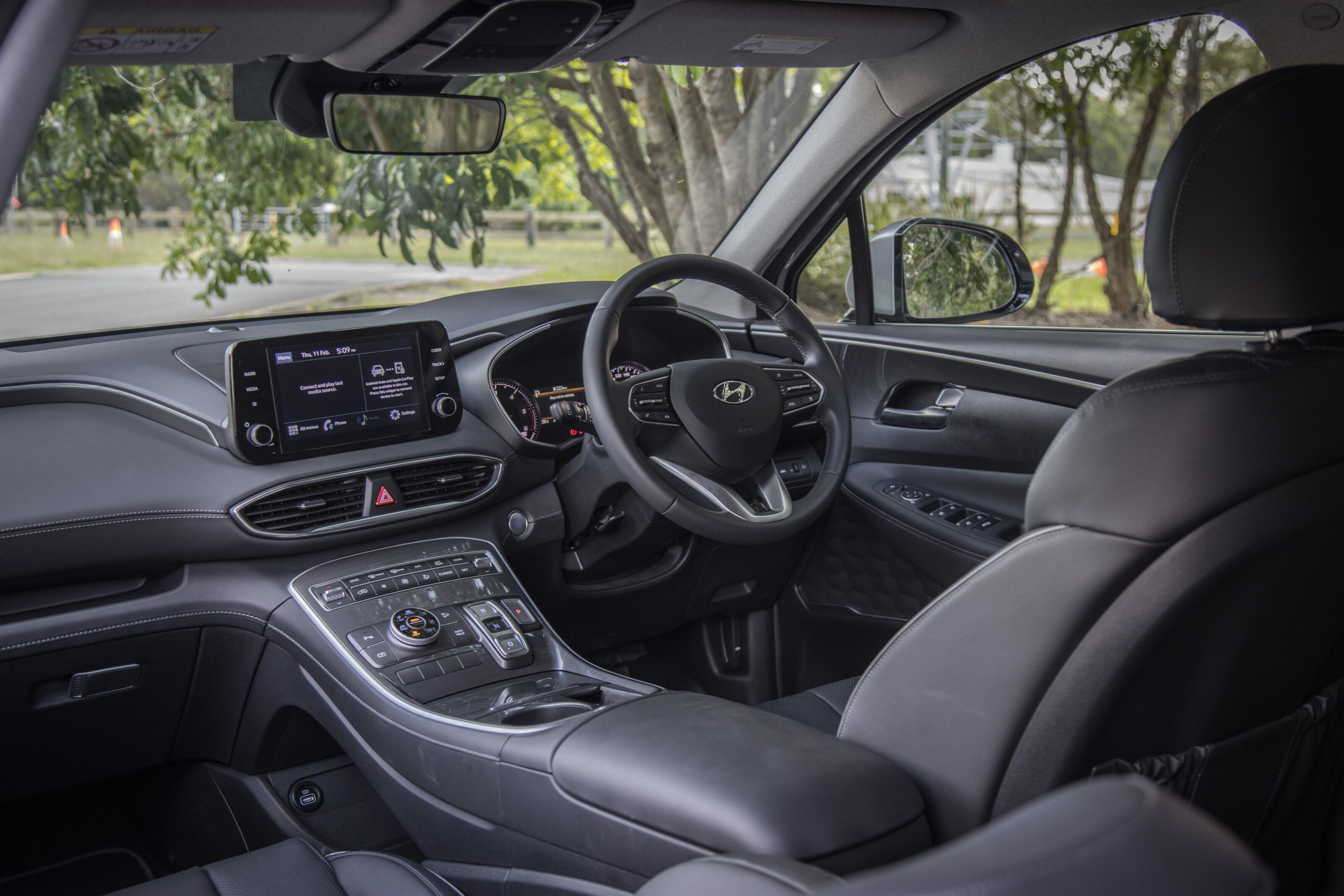
The Santa Fe makes a strong first impression with its hatchback-like demeanour in urban or suburban driving.
From Active grade up there’s dual-zone climate control, front parking sensors, rain-sensing wipers, rear privacy glass and paddle-shifters plus a new rotary drive mode selector.
Adding to the long list of standard safety tech – more on that later – the Santa Fe Active packs an electronic child lock for rear doors and windows plus features that prevent the doors from being opened if another road user is approaching and remind the driver to check the rear seats for pets, people and possessions before exiting.
The base model’s 17-inch alloys are replaced with 18s on the Active, which also gets electric folding mirrors and puddle lamps.
Considering the modest $3600 Hyundai asks for all these extras on the Active, forking out $6000 more for the Elite plus another $7400 on top of that for the Highlander seems like diminishing returns for mostly toys and trim.
Our ideal Santa Fe would be an Active with integrated rear window shades, media system and powered tailgate from the Elite plus the Highlander’s digital dash with blind-spot camera view.
We’d call it the $3000 Active Family Pack. How about it, Hyundai?
Ownership costs
Hyundai provides a five-year unlimited kilometre warranty, which has become something of an industry standard.
Servicing happens every 12 months or 15,000km – pretty standard stuff – with Hyundai quoting $459 for each of the first five intervals at the time of writing and up to five years’ servicing locked in at this price available for pre-purchase.
That’s a less costly than maintaining a Kia Sorento but more expensive than a diesel Mazda CX-8. Perks of servicing a Hyundai on schedule at one of its dealerships include annual extensions of the standard 12-month roadside assist cover.
During our two weeks with the Santa Fe Active diesel, Hyundai’s fuel consumption claim of 6.1L/100km on the ADR combined cycle proved pretty accurate and a big improvement over the outgoing model’s 7.5L/100km.
Considering the amount of time spent idling and shunting around during video and photography sessions, 6.7L/100km on the trip computer was an outstanding result and provided us with a theoretical 1000km range from the 67L tank, which would cost $87 to fill at $1.30 per litre.
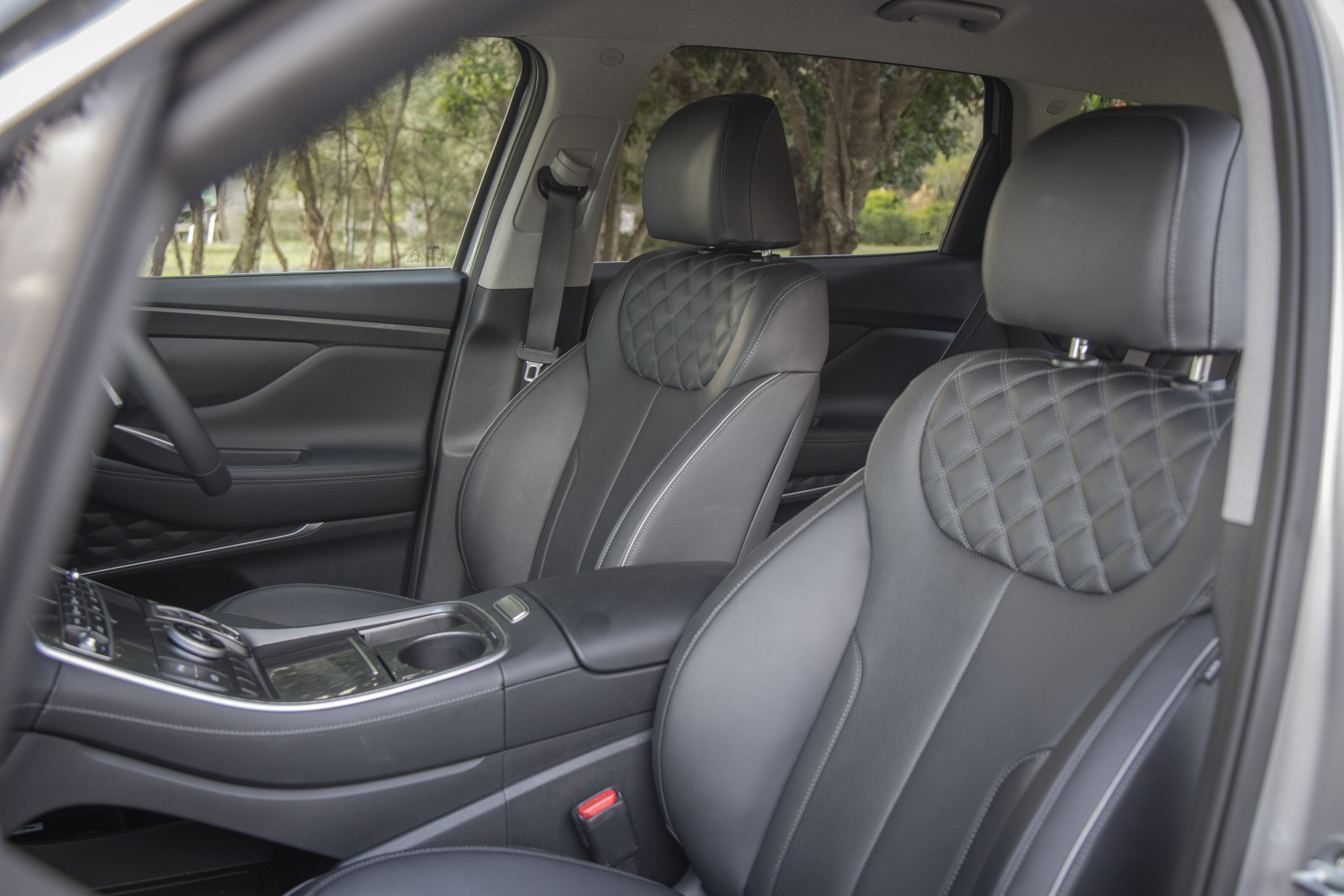
Comfort and convenience
Much of the updated Santa Fe interior layout and look is initially familiar, the most noticeable architectural change being a two-deck centre console – not present in the base Santa Fe – that easily accommodates a loaf of bread and two-litre milk carton on its lower level.
Above, the traditional gear selector has been replaced by metal-look push-buttons alongside redesigned switchgear that is similarly chunky and intuitively located.
Staggered-height cup holders make perfect sense in practice and it’s great to see a conveniently located vertical wireless phone charging pad from base spec up.
A big storage bin is found beneath the central armrest but there is nowhere obvious to store sunglasses. Four USB ports are distributed across the front and middle rows of the Active, while Elite and Highlander have another pair in the third row.
Elite and Highlander variants sport big digital display but our Active shares the base grade’s basic 8.0-inch infotainment system that relies on owners running most functions through Apple CarPlay and Android Auto, the former being unusably glitchy on our test car.
Apart from that, audio quality is decent and a there’s a useful voice memo function that can export your musings to a USB drive.
Hyundai might have set a segment benchmark with the Santa Fe’s front seats. Even with the Active’s manual adjustment, support, angle, driving position and long-distance comfort are flawless.
Row two is now much more spacious, to the tune of 39mm in additional legroom for greater cabin flexibility when the independently sliding and reclining sections of the 60:40 split bench are configured to balance capacity between the second row or and third row or boot.
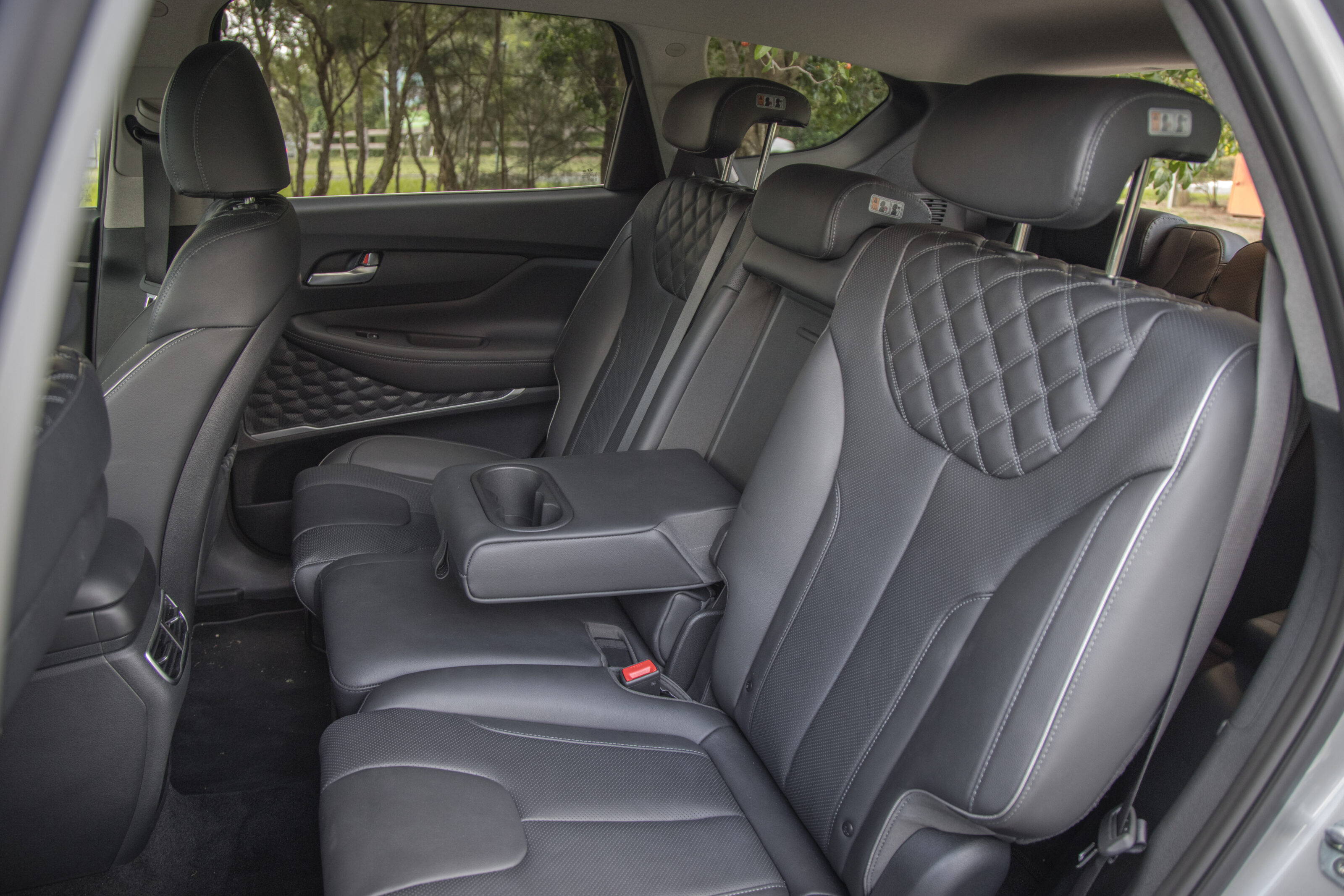
The bigger shell yields an additional 24L of boot space with the third row folded away – now from 571L to 782L depending on how you position the second-row seats – but with the third row in place capacity remains a measly 130L, so good luck on the grocery run.
Seat comfort and space is great in row two, apart from the thinly padded central position.
Capacious map pockets and more usable door bins than those up front are provided, but they’re similarly unsuited to tall bottles. If not using the middle seat, the fold-down armrest offers better drinks holders.
A trio of top tether anchorages offer the possibility of installing three child seats, the outer two of which can be secured using ISOFIX.
However, the third row remains cramped in all directions and because there are no child seat anchorages back there, the Santa Fe only provides a short window of time between rearmost passengers being no longer legally obliged to use child seats and being too tall to fit. Worse, the side curtain airbags do not extend far enough back to fully protect third-row passengers.
Upsides include generous seat padding, adjustable air-con vents with fan speed control, cup-holders and rectangular storage trays for each seat.
Accessing the Santa Fe’s third row is only possible from the passenger side, via simple push-button activation of the corresponding second-row seat’s tilt-and-slide mechanism.
It’s good to have this on the kerb side when street-parked, but both third-row passengers are forced to file in and out of one door.
Also, the seat release and remote second-row folding buttons invite mid-journey mischief as they’re within easy reach of third-row passengers and can be operated while the vehicle is in drive.
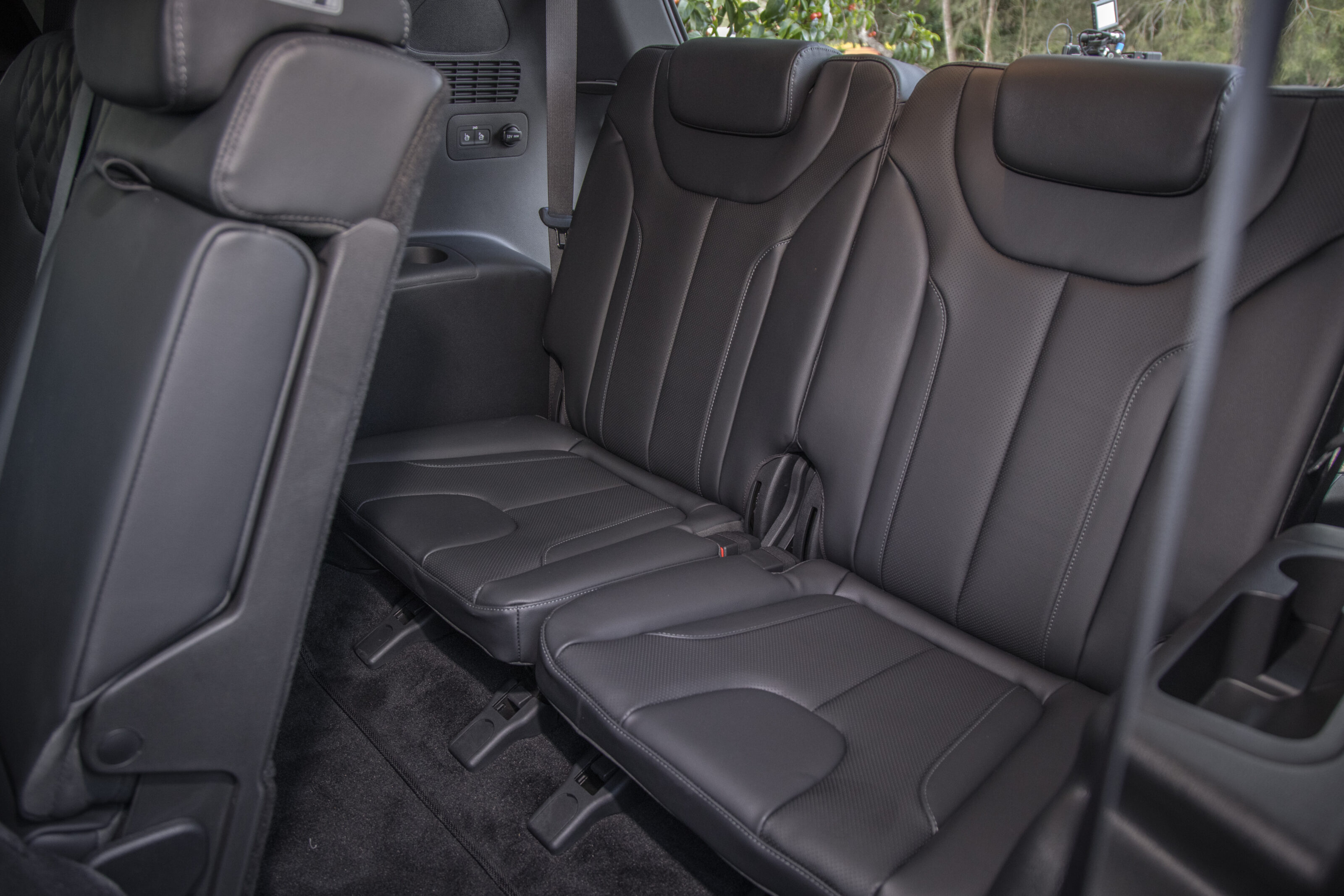
Safety
Hyundai has overhauled the Santa Fe’s standard safety tech suite, with a major upgrade to forward collision mitigation system that can now detect obstacles at junctions and automatically brake to avoid – or at least reduce the severity of – these types of collisions.
Also standard are driver attention monitor, rear-cross traffic avoidance and a blind-spot monitor including collision avoidance assistance. Tyre pressure monitoring is included and all variants come with a full-size spare.
Accurate adaptive cruise control with stop and go function combines with lane-keep assist to reduce driver effort and stress levels on long motorway journeys and in heavy traffic.
However, lane-keeping gets a bit intrusive on narrow twisty roads and takes a long, firm press of the relevant button to disable.
Driver visibility is excellent in the Santa Fe, with deep windows and big mirrors plus a crisp reversing camera image. Kids enjoy a good view out from the second row, although the third row gets little portholes.
There are six airbags – none in the third row – and despite deep engineering changes, the Santa Fe inherits its predecessor’s five-star ANCAP crash-test rating.
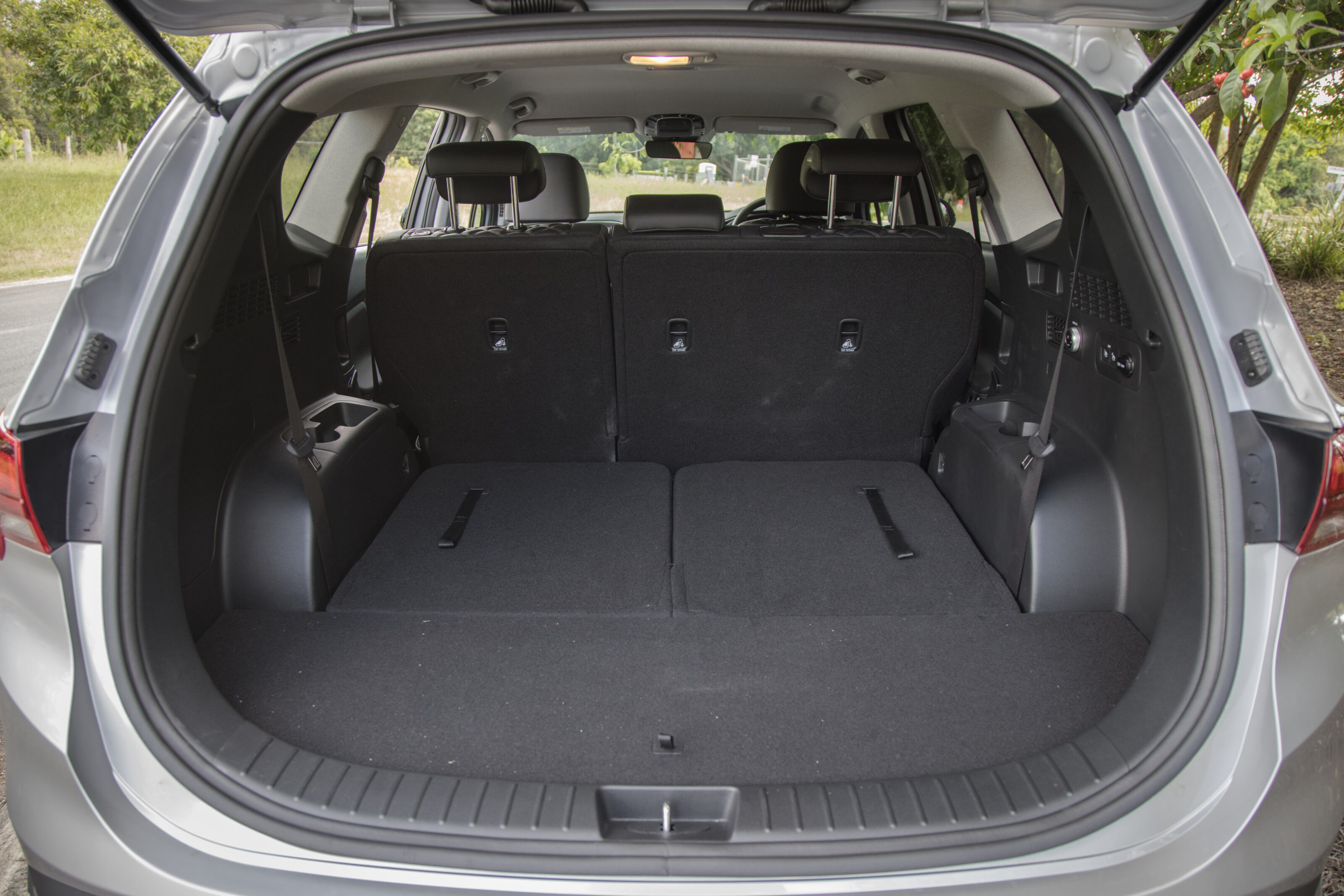
Power and performance
Hyundai says it has made the Santa Fe’s 3.5-litre petrol V6 and 2.2-litre four-cylinder turbo-diesel engine options lighter, with less internal friction.
This 2.2-litre four-cylinder turbodiesel develops 148kW – 1kW more than previously – while torque remains at 440Nm, similar outputs but 10Nm down on torque compared with the same-sized diesel in a Mazda CX-8.
On the road, this reduced friction and inertia combine with the new underpinnings to lend the diesel Santa Fe a smoother, quieter driving experience.
It’s effortless once up and running, with swelling mid-range acceleration and unlike the previous Santa Fe, there’s no step-off lag.
This could have a lot to do with the diesel’s new dual-clutch automatic transmission, which we’d wager also helped the big improvement in fuel efficiency compared with the V6 that retains a torque converter auto and is only a tenth less thirsty at 10.5L/100km while outputs have dropped slightly to 200kW/331Nm.
So seamless and intuitive is the diesel’s new cog-swapper in general driving that we regularly forgot it was a dual-clutch. Hyundai has done an impressive job of ironing out so many kinks typical of this transmission type.
Even on challenging twisty roads it always seems to be in the right gear, the revs changing exactly when we’d be making a manual shift using the paddles.
Only hill-starts or tight manoeuvres on inclines reveal a couple of quirks, such as unexpected revving or disconcerting hesitation between reverse and forward gears.

How does it drive?
The Santa Fe makes a strong first impression with its hatchback-like demeanour in urban or suburban driving. It feels uncannily small and nimble for a seven-seat SUV, shrinking around the driver and responding without the expected inertia.
At suburban speeds, ride quality delivers a sense of road texture without intrusive jostling or jolting over surface imperfections. On motorways or country roads it settles into a comfy kilometre crusher, making the Santa Fe a great partner for family road-trips or travelling far and wide for work.
The finer points of handling are going to be of little relevance to the average Santa Fe buyer, but it helps if your family car is an enjoyable steer and sound dynamics can help avoid the complaints and consequences of motion sickness that mum-and-dad drivers dread, forcing them to drive so slowly that an impatient queue forms behind.
Good news on that front. Our Active diesel would happily barrel along a curvaceous country lane without disappointing the driver or alarming their passengers. Few seven-seat SUVs achieve that, none of them Japanese.

The Kumho tyres provide sufficient rather than spectacular grip, and are quick to start howling when pushed. What stands out is how controlled and predictable this car feels, which is comforting if you ever need to take evasive action with precious cargo onboard.
Patchwork corner surfaces and mid-bend ridges or crests rarely unsettle the Santa Fe, which holds its line doggedly while being surprisingly communicative about what is going on below deck.
These dynamic smarts pay dividends on gravel, where Hyundai’s HTRAC AWD setup also gets the power down with minimal fuss and 60-section rubber provides plenty of sidewall squish to absorb unsealed road craters that would jeopardise the 20-inch rims of a higher-spec Santa Fe.
Sand is the terrain mode that makes most sense on gravel, amping up the throttle response in case the going suddenly gets soft or things end up a bit out of shape mid-corner.
Overall, the updated Santa Fe is an easy-going all-rounder and a pleasure to both drive and be driven in.
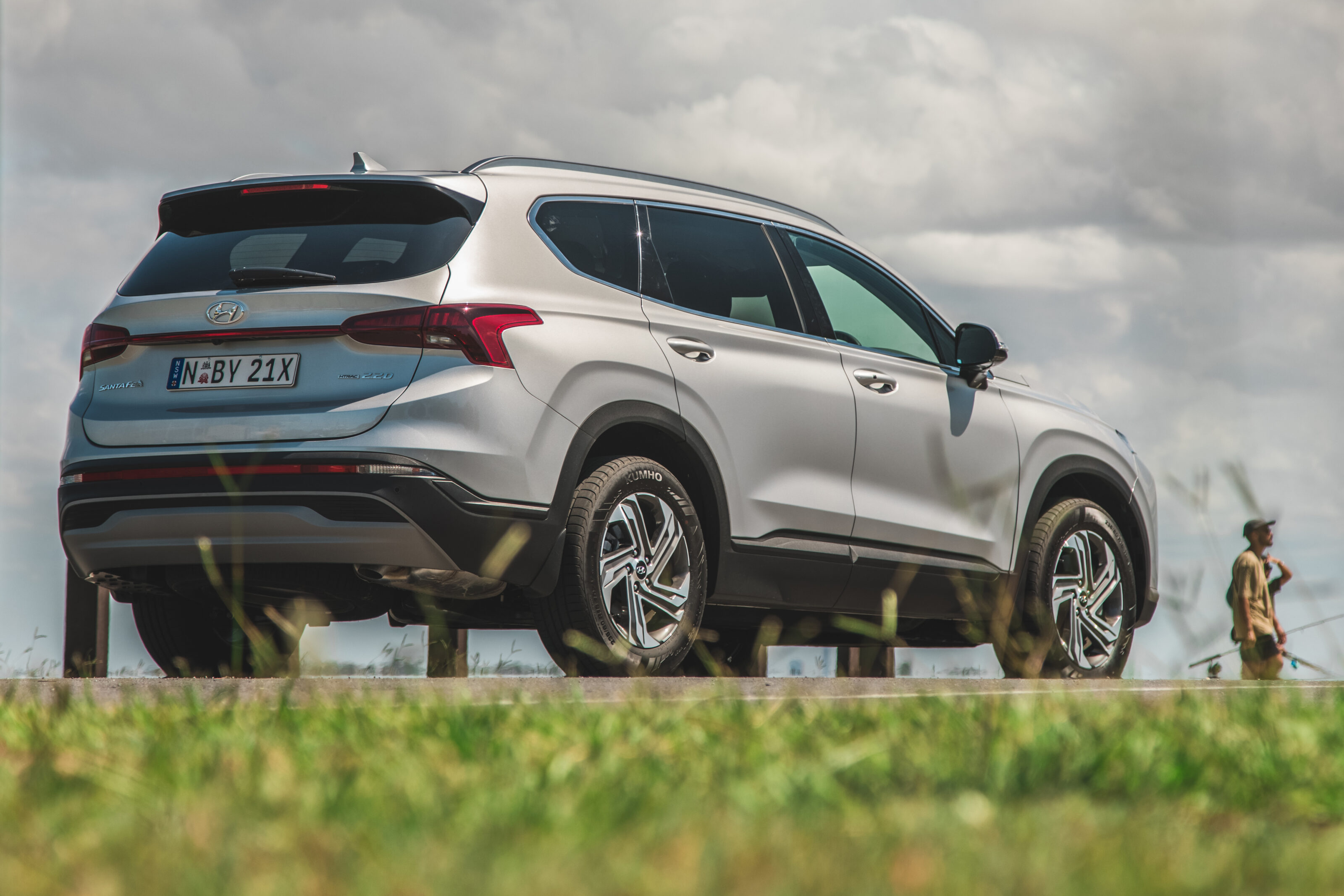
VERDICT
With substantial improvements throughout, a cabin that is better put together with new luxury trim that adds genuine wow factor and a driving experience that has matured without losing its youthful vigour, the new Santa Fe truly ranks among the segment’s best.
And, as is the modern Hyundai way, the value equation is competitive rather than outstanding. But the Active is by far the sweet spot in that regard.
By concentrating on making the interior bigger for second-row passengers it’s as though Hyundai has just accepted that customers will look elsewhere for a more usable – and safer – third row.
Perhaps it’s no coincidence that the company introduced its massive eight-seat Palisade at around the same time.
Score breakdown
Things we like
- Value for money
- Quality and comfort
- Fuel consumption
Not so much
- Poor third-row access and space
- No third-row airbags
- Glitchy Apple Carplay implementation

